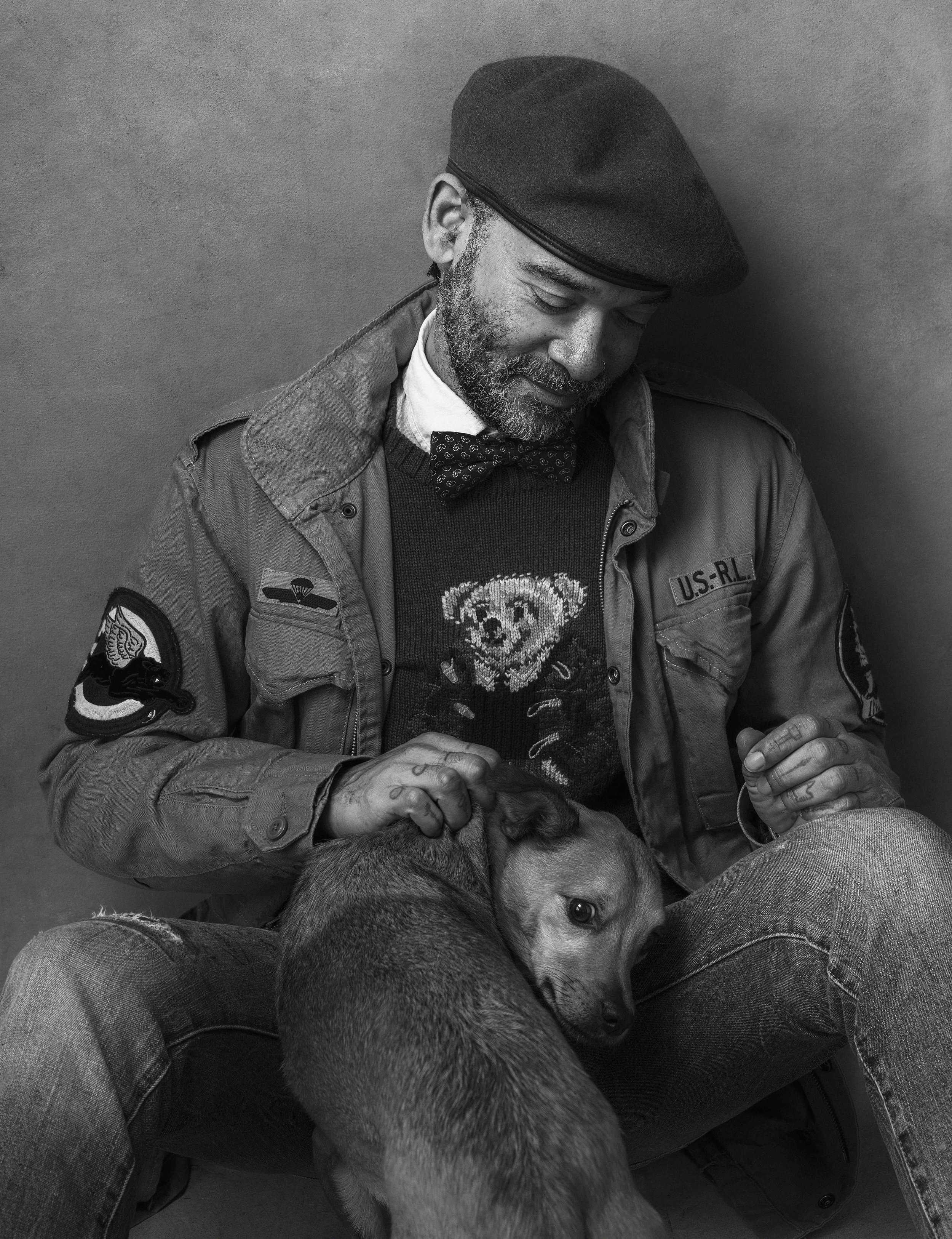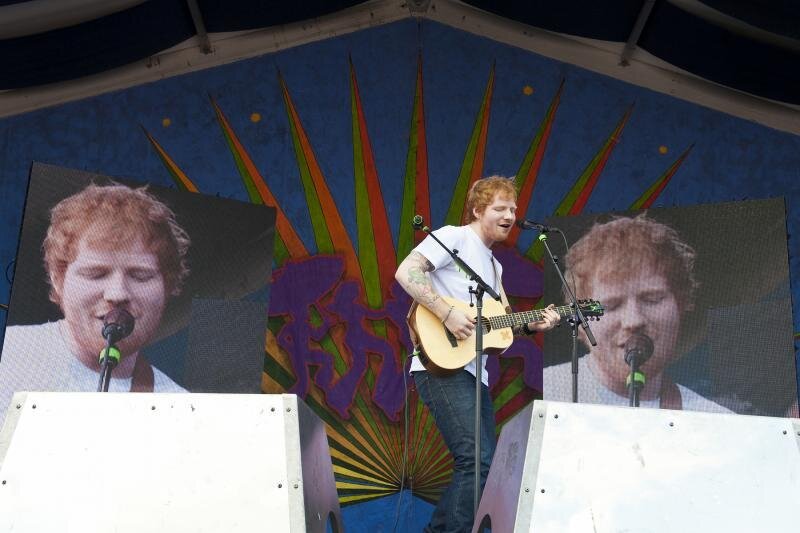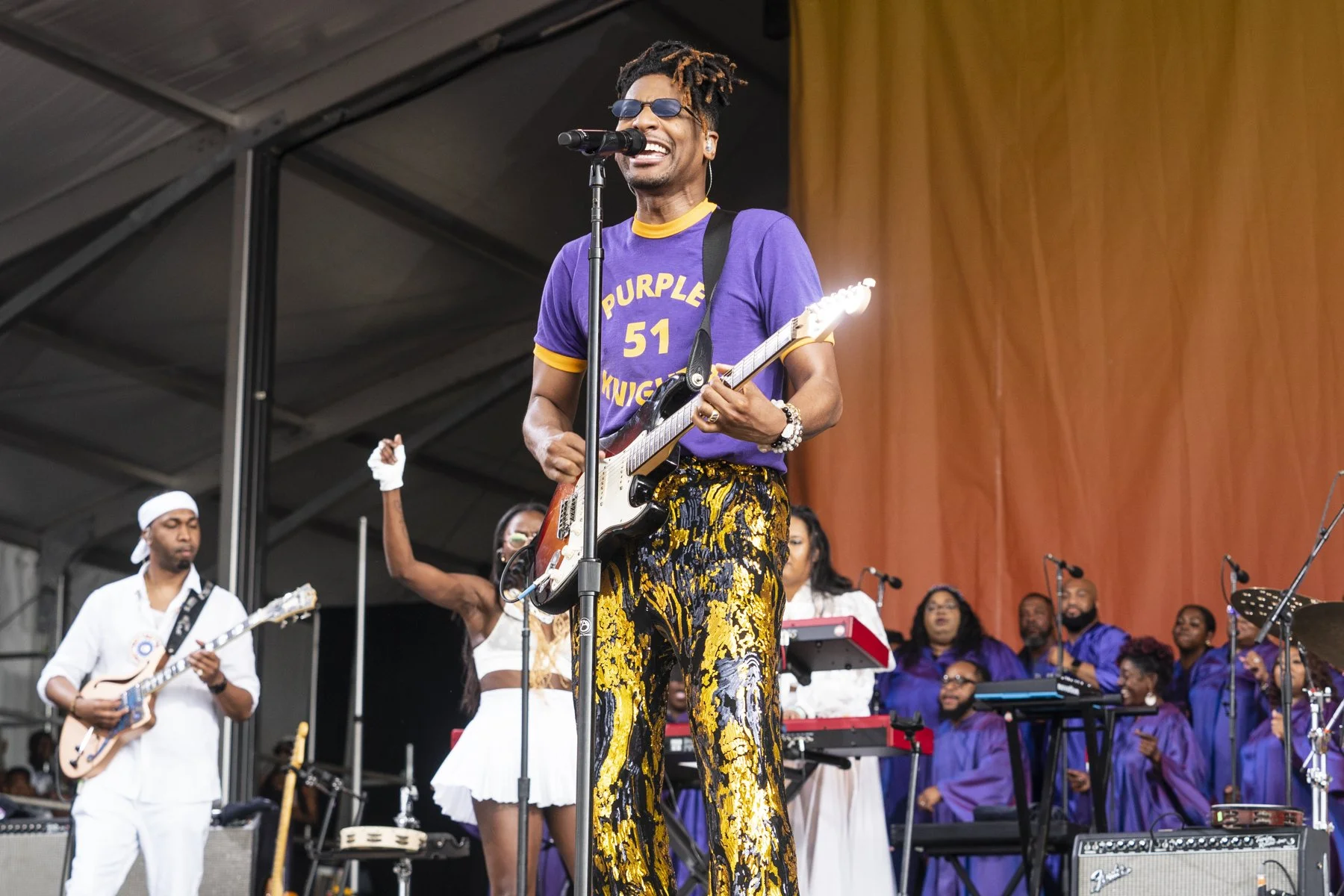ÌFÉ Found Itself in a Magazine Logo, Plays Jazz Fest 2023

Otura Man of ÌFÉ, by Greg Miles
Otura Mun’s electronic take on Cuban rumba is just one of many layered elements in the story of the project.
“I had the name and branding before I had any music,” Otura Mun of ÌFÉ says. He was going through a back issue of Life magazine one day with pictures from 1965’s Watts Riots, and it occurred to him first how perfect Life’s logo was, and then how he could use it. “If you knock the ‘L’ off, you get ÌFÉ, which is love and expansion in Yoruban, which is the cult that I’m initiated in,” he explains.
The white letters on the bold red background were similarly resonant because they’re the colors associated with Shango, “the owner of music and dance,” and in that logo, ÌFÉ found a musical concept. Mun had been thinking about a producer project for himself since he had been doing a lot of work for other artists, and the logo told him it should focus on the spirit of Coltrane blessed by Shango.
“Higher Love” isn’t pure ÌFÉ, but it’s the easiest starting place. He recorded a version of Steve Winwood’s hit from 1986, and by boiling it down to percussion and piano chords that hang patiently, ÌFÉ transformed the song into a prayer. Mun sings it quietly, not selling anything, and his performance isn’t a rallying cry. His prayer doesn’t make a presentation of his spirituality or try to rope in believers. Instead, it placidly invites those who share his fears to join him, and it makes a simple request for a purer, transformative love. Something that will help unite us and get us through these frightening times.
ÌFÉ’s prayer is a contemporary one, with Auto-Tune manipulating his voice for flickering moments. We’re digital, technological presences as well as physical beings, and prayers that genuinely engage us will engage us on multiple levels. Pop culture shapes our language, so it makes sense that it also gives us our prayers, even if we didn’t hear them that way at first. Once you get “Higher Love,” you understand what ÌFÉ is doing, making prayers for the times we live in.
ÌFÉ will play Jazz Fest’s Cultural Exchange Pavilion on Saturday at 12:45 p.m.
Mun is making coffee all in the kitchen of his Uptown shotgun with the front and back doors open so we can enjoy the cross breeze as intended. He warms to conversation about his visual presentation since much of the press around ÌFÉ begins and ends with Yoruba. He taught himself Photoshop to make posters for parties, and he is clearly proud of his graphic communication. The title of the album that gave us “Higher Love” is 2017’s IIII + IIII, a title he literally mimics on the cover photo with his hands in the air, four fingers on each one extended vertically, with the cross on a church between them. “It’s like, I’ve got my hands up. Don’t shoot,” he explains, thinking of #BlackLivesMatter and Michael Brown’s hands in the air before he was shot by the police in Ferguson, Missouri.
In 2021, he released 0000+0000, and he’s similarly proud of that cover. He saw the picture, which is a negative of a photo of San Francisco at night, in a book by Luke Atwood Abiol. He planned to ask him to shoot a similar shot for the album but realized that would be redundant and instead got permission to use it.
“I’d like to have a design team, but for now it’s just me and my iPhone,” Mun says, and it’s hard to see how things could work better. Abiol’s photo suggests an unseen energy that unites, and by locating it in a city, that connection seems urban and contemporary, not part of a rural, island spirituality.
ÌFÉ, by Greg Miles
Mun knows that ÌFÉ is a complicated, nuanced beast. He’s pursuing traditional music through electronic means, and that’s something that the audiences for each half of that equation are unsure that they need. The Portuguese Enchufada label has released simpatico music, but it was important to Mun to find a musical home in America. He had a manager who could find European labels for him, but as an African American, he thought of his music as Black American Music despite making it in the Caribbean, basing it on Afro-Cuban musical traditions, and infusing it with Afrofuturist concepts.
“There’s a band called Death that was a punk rock band that’s part of the Black American musical legacy,” he says. “I am also part of that, and the idea that there’s a label that would represent fringe elements of that story, I have more to do with that.” That’s a connection he admits he might not have made before moving to Puerto Rico.
Mun grew up in the small town of Goshen, Indiana after being adopted when he was six months old. His adoptive mom played the piano and wanted all the kids to play an instrument. “I played the drums, partly out of spite,” Mun says, laughing. He started taking lessons in fifth grade and in high school had an inspirational experience with a drum line teacher from Drum Corps International, an organization that helped standardize drum and bugle competitions around the country.
“He was one of the most charismatic people I’ve ever met. He’s the kind of guy who can up everybody else’s potential energy just by his exuberance.” While in high school, his drum line won a regional competition, and he visited New Orleans for the first time in 1992 to compete at a Percussive Arts International conference as a tenor drummer. He took second competing against college students, and at the encouragement of one person who saw the performance, he sent a video of his performance to the University of North Texas, which was a prestigious school in the drum line world. He competed as a freshman against 270 other drummers for the one available slot on the North Texas drum line and got it, along with a scholarship.
Practice was relentless from the start of school until the competition in November, and Mun recognizes that the drum line was as good as it was because the head of the program recruited the top talent and made them work like hell. “Stack the deck in your favor and overprepare--that’s still my work ethic,” he says, laughing. Mun didn’t know enough about Cuban rumba to recognize the the difference between the good and the great players when he moved to Puerto Rico in the late 1990s, so at first he put together a band that would get along. He realized that not everybody had his work ethic, though, and that they weren’t prepared to log the hours he would to improve.
“I didn’t pick up a hand drum until 2012, and I made ÌFÉ in 2015,” he says. “In that time, I locked myself in my room and studied Cuban rumba in the way I studied when I was in Texas. For three years, I disappeared off the map.” He didn’t only teach himself to play. He taught himself the sound as a language and culture so he understood how and why musical choices were made.
Mun made music in Puerto Rico for 21 years, but he felt it was time to go when his profile started to rise. He was conscious that even as an African American, he was a colonizer in Puerto Rico, and when the music media looking to write about music in Puerto Rico started talking to him instead of native Puerto Ricans, he moved on. “I want to have my story told,” he says, thinking back to that time. “Do I think I make better music than that guy? Yeah, I think I do. But, what does Puerto Rico need? I think they need to celebrate themselves because they have everything else in the world telling them they’re not good enough.”
Like his cover art, the impetus to move to New Orleans came not through a linear process but a confluence of events.
The final push to leave came in 2020 after George Floyd and Ahmaud Arbery were murdered by the police. He recalls intellectuals in Puerto Rico debating whether to back #BlackLivesMatter, “and that debate was remedial to me,” Mun says. When he saw people taking down Confederate monuments, he saw people in the space he emotionally and intellectually occupied as they tried to, in his words, “dismantle heavy pieces of the American Myth.” He considered New Orleans and Detroit as landing places because they were the blackest cities he could think of, and he favored New Orleans because its history suggested that he might find sympathetic ears here.
Around that time, New Orleans-based djembe player Weedie Braimah reached out unexpected and asked Mun about touring together. Mun was also a fan of Christian aTunde Adjuah and saw a musical community where he might make sense. He has become friendly with percussionist Bill Summers since moving to town. “Bill understands me,” Mun says.
Making electronic music marked his work as something superficially different from his contemporaries, but superficial was enough to throw some people. Still, he felt it was important to have the electronic component because “it’s what was happening at the time,” Mun says. It guaranteed that his music wasn’t seen as something that only lived on a Smithsonian Folkways collection and marked the period when it was made.
“It took a while to find the language to speak my spirit,” he says. Jazz wasn’t his native tongue despite his training, and neither was hip-hop even though he worked as a DJ and producer. When moving the vinyl that served as his sample library became to burdensome, he said goodbye to the collection and that as his musical outlet. In the end, Cuban rumba made the most sense. “With very few people, the musical conversation can be at a super high level,” he says, and it helps that people don’t have to know it well to appreciate it. “You can get it better if you know it, but you can hear it cold “and love your life.”
Otura Mun, by Greg Miles
Creator of My Spilt Milk and its spin-off Christmas music website and podcast, TwelveSongsOfChristmas.com.








